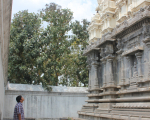A deeper understanding of the history, heritage and culture of the Tamil Jain community is key to arriving at a clearer, less hegemonic and more inclusive picture of the region’s past. This is especially important due to the significant role played by the Tamil Jains in shaping the region's culture and society.
From a once dominant group in the first millennium CE to a marginalised minority today, the Tamil Jains have come a long way. While popular history and collective memory often relegates them to the past and considers them as a passing phenomenon, it is crucial to address such misconceptions.
While Jain myths point to their entry into the region around the third century BCE, historians such as R. Champakalakshmi have ascertained that stone beds and caves accompanied by Tamil Brahmi inscriptions, often dating to the second century BCE to the third century CE, are proof of the early spread of Jainism in the region. The religion, with a large number of followers, was at its height in the first millennium CE. This photo essays showcases two Tamil Jain sites—Samanar Malai, near Madurai, and Mel Sithamoor, near Tindivanam—which belong to different periods. These different Tamil Jain sites can be used as an entry-point to understand the community’s socio-economic contexts over a period of time.
It is especially crucial to note that that even during the British rule, several Jain sites and statues were mention in surveys conducted by the Archeological Department in the South. The mention of Jain monuments, sites and objects in these reports is largely in the context of conservation, repair, acquisition, or as a treasure-trove find.
Apart from Mel Sithamoor (Chittanur) and Samanar Malai, some of the Jain references in these reports include: Annamalai/Yanamalai, Chengalpattu, Kazhugumalai, Madurai, Madras, Tiruchirappalli, Tiruparuttikundram, Nagapattinam, Vallimalai, Tirunathar Kunru.
More recently the French Institute of Pondicherry documented over 420 Jain sites in Tamil Nadu.
Jain architectural heritage falls into four categories: structural temples (like the Trilokyanatha Temple in Tiruparuttikundram, Kanchipuram district); caves (like the ones in Samanarmalai, Madurai; there are around 16 caverns around Madurai itself); bas-reliefs on boulders and hillocks (as seen in Kazhugumalai, Tirunelveli district); isolated statues (such as this 9th-10th century statue of Mahavir, discovered near Madurai in 2006).
However, most Jain sites seem to be in secluded areas with scant population, especially the Jain population, and many sites are difficult to access even today. For instance, while noting the condition of Yanamalai, Madurai, the annual report of Archaeological Survey of India Collections: Southern Circle, 1907–10 mentions, 'The Jaina sculptures on the boulders above the cave are difficult to access, as there is no properly formed roadway leading to them.'











